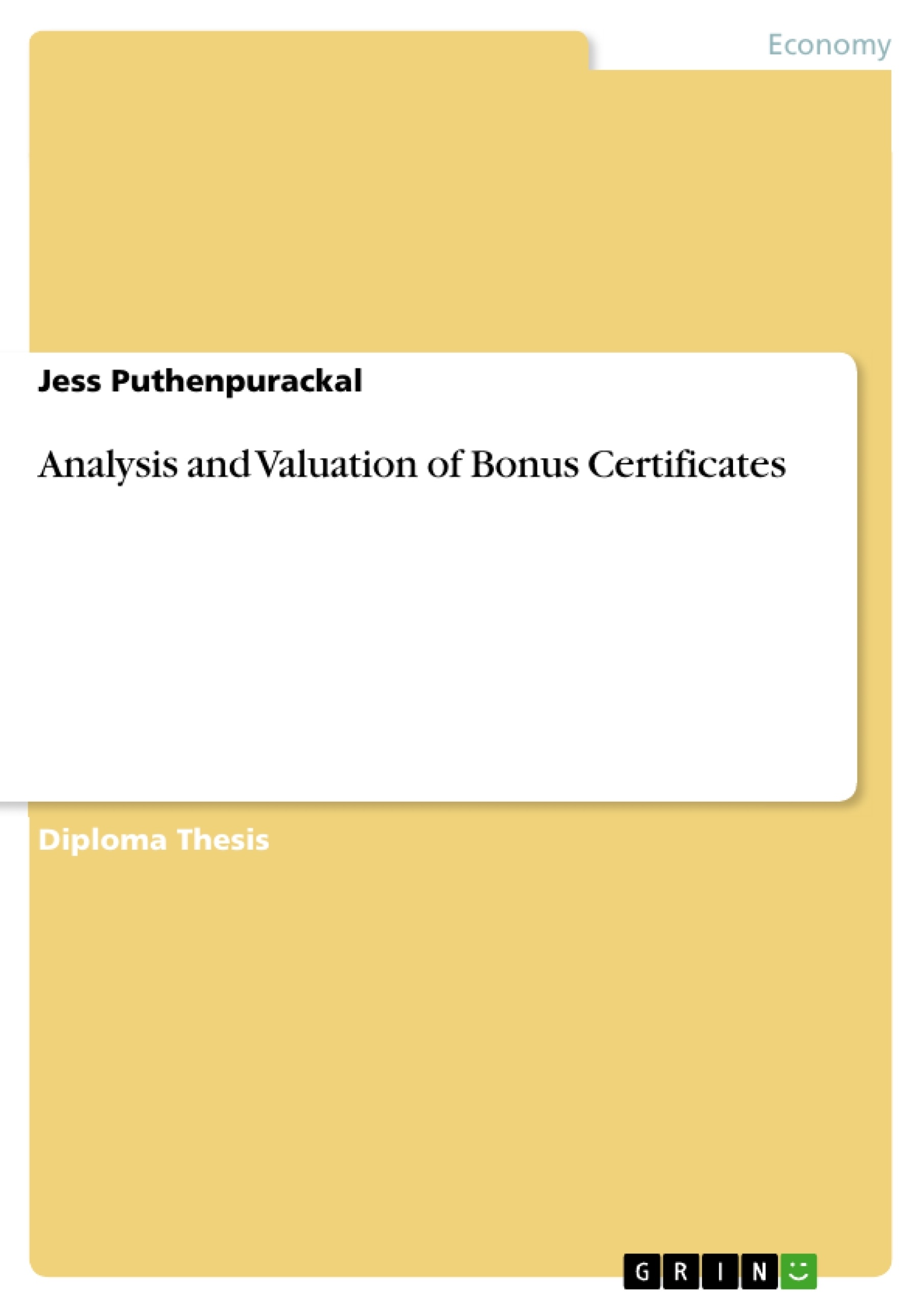Since 1989, retail certificates have become core in the field of retail banking (Pilz 2006). Particularly, the stock crash between 2000 and 2003 has fostered the success story of these investment products because many private investors have sustained enormous losses with their stock exposures. Therefore, they have been looking for alternatives to traditional investment forms which are lower in risk but gaining satisfactory returns (Schiereck 2004).
In order to fall in line with this growing specific demand of investors, major German banks have invented the new asset class of retail certificates. These products can offer depositors characteristics for every market scenario as its explicit strength (Löhr and Cremers 2007).
This booming development reached its peak in December 2007, as German private investors hold 135 bn EUR of retail certificates in their deposits (Barthel 2008).
Because of their attractive risk-return profile, Bonus Certificates, which were issued for the first time by the German bank Sal. Oppenheim in 2003, have gained a key position in this sector with a market share of 21.9% (Fischer 2008). The barrage of newly issued products has led to the circumstance that many private investors are facing the problem of lack in transparency concerning the structure of Bonus Certificates.
The present diploma thesis intends to provide the reader an extensive overview on the investment segment of Bonus Certificates. Thereby the author focuses on the conception and pricing of this financial structured product in order to develop an investment guideline for investors, how to deal with this complex derivative. In particular, the author analyses the influence of the input factors, both on each embedded option component and on the Bonus Certificate as a whole. Hence, investors may get a better insight of the disproportionate valuation of Bonus Certificates over maturity.
Due to current negative market situation, the author has also a look into the impact of issuer’s default risk and barrier violation on Bonus Certificates.
Table of Contents
- Introduction
- Problem Definition
- Procedure
- Basics
- Definition of Certificates
- Components of Certificates
- Fixed Income Securities
- Stocks
- Standard Derivatives
- Options
- Futures
- Exotic Options
- Benefits of Bonus Certificates
- Investors
- Issuers
- The German Bonus Certificates Market
- Characteristics of Bonus Certificates
- Description of Bonus Certificates
- Underlying
- Conversion Ratio
- Barrier
- Bonus Level
- Maturity
- Default Risk
- Costs
- Design of Bonus Certificates
- Zero-Strike-Call
- Down-and-Out Put
- Payoff-Profiles
- Pricing of Bonus Certificates
- Black-Scholes-Model
- Underlying
- Volatility
- Dividends
- Interest Rate
- Maturity
- Divergence of Pricing: Fair Value - Secondary Market
- Taxation
- Special Forms of Bonus Certificates
- Capped Bonus Certificates
- Quanto Bonus Certificates
- Reverse Bonus Certificates
- Multi Bonus Certificates
- Empirical Analysis
- Dresdner Bonus-Barrier-Certificate I
- Description
- Design
- Pricing
- Taxation
- AGI Bonus Barrier Fund
- Description
- Design
- Pricing
- Taxation
- Comparison: Dresdner Bonus-Barrier Certificate - AGI Bonus Barrier
- Impact of current Stock Exchange Collapse on Bonus Certificates
Objectives and Key Themes
This diploma thesis analyzes and evaluates the concept of bonus certificates, exploring their structure, pricing, and performance in the context of the German market. The study examines the benefits and risks associated with these financial instruments for both investors and issuers. The thesis also investigates the impact of the global financial crisis on the bonus certificate market.- Analysis of the structure and pricing of bonus certificates
- Evaluation of the benefits and risks of bonus certificates for investors and issuers
- Examination of the German bonus certificate market, including market trends and market share
- Assessment of the impact of the financial crisis on the bonus certificate market
- Empirical analysis of specific bonus certificates
Chapter Summaries
The introduction defines the scope of the thesis and outlines the research methodology. Chapter 2 provides a comprehensive overview of certificates, defining their key components and exploring their underlying securities and derivatives. Chapter 3 examines the benefits of bonus certificates for investors and issuers and analyzes the dynamics of the German bonus certificate market. Chapter 4 delves into the characteristics of bonus certificates, covering their design, pricing models, and tax implications. Chapter 5 presents an empirical analysis of two specific bonus certificates, exploring their structure, pricing, and performance. The final chapter concludes the thesis, summarizing key findings and discussing the implications of the research.
Keywords
This thesis focuses on the analysis and valuation of bonus certificates in the context of the German market. The key concepts explored include: * Bonus Certificate Structure and Design * Pricing Models (Black-Scholes-Model) * Risk and Return Analysis * Market Trends and Market Share * Taxation and Legal Framework * Impact of Financial Crises on Bonus Certificates * Empirical Analysis of Specific Instruments * Investors and Issuers * German Bonus Certificate Market- Quote paper
- Dipl.-Kfm. (FH), BBA Jess Puthenpurackal (Author), 2008, Analysis and Valuation of Bonus Certificates, Munich, GRIN Verlag, https://www.grin.com/document/118401



